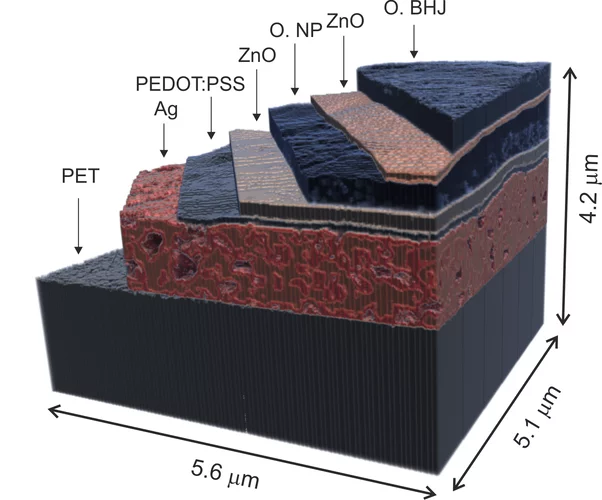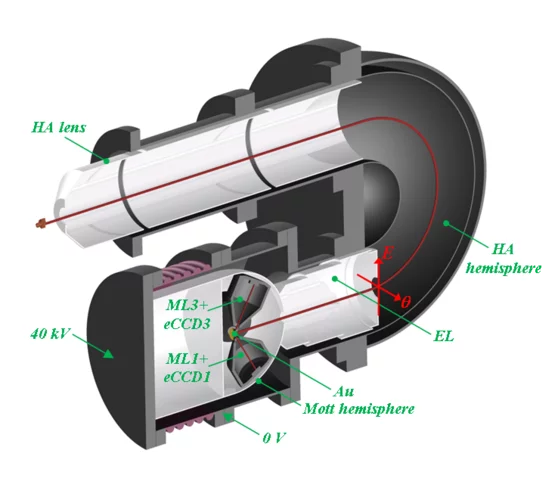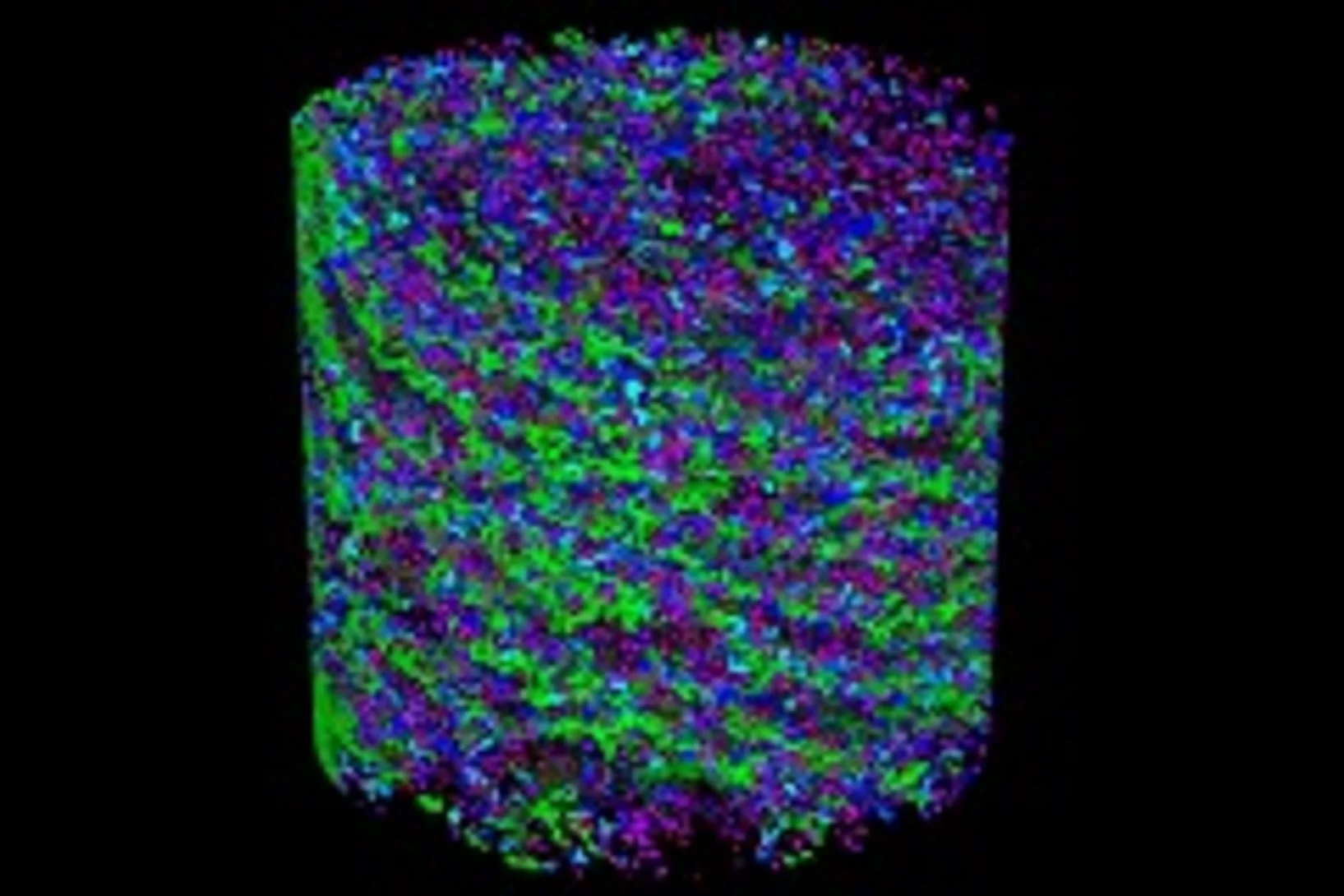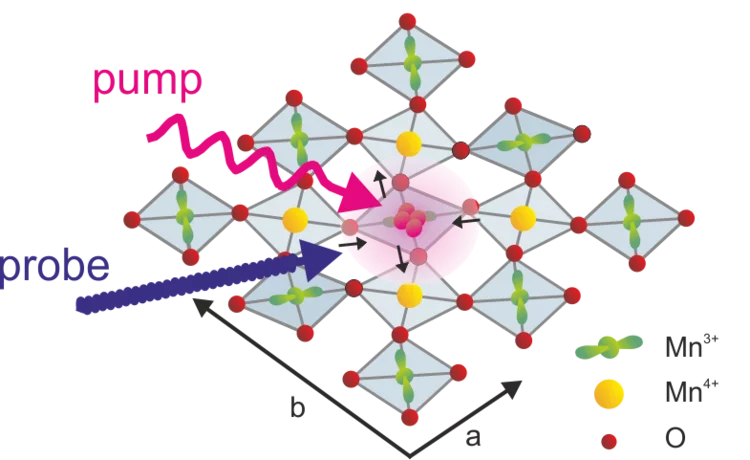X-ray nanotomography aids the production of eco-friendly solar cells
Polymer solar cells are in the spotlight for sustainable energy production of the future. Characterization of these devices by X-ray nanotomography helps to improve their production using environmentally friendly materials.
Un cousin de l’électron finalement observé au bout de 86 ans
Dans le cadre d’essais à la Source de Lumière Suisse SLS, des physiciens de l’Institut Paul Scherrer PSI dans une collaboration internationale avec des collègues de la Chine, de l’EPF Zurich et de l’EPF Lausanne ont observé une particule dont l’existence avait été prédite il y a déjà 86 ans. Cette nouvelle particule fait partie de la même famille que l’électron, le porteur de courants électriques. Contrairement à l'électron, la nouvelle particule n'a pas de masse et il n’apparaît que dans une classe particulière de matériaux qui sont dénommés des métaloïdes de Weyl.
Controlling tunnelling in methane loss from acetone ions by deuteration
At the imaging Photoelectron Photoion Coincidence (iPEPICO) endstation of the VUV beamline evidence of H-atom tunneling was shown.
La structure de la maladie du béton
a été décryptée
Quand ponts, barrages et autres ouvrages en béton se retrouvent striés de fissures sombres au bout de quelques décennies, c’est que la maladie du béton est à l’œuvre. Des chercheurs de l’Institut Paul Scherrer PSI et de l’Empa viennent de réussir à décrypter au niveau atomique la composition du matériau qui apparaît dans ces fissures. Ils ont découvert un agencement atomique cristallin, inconnu à ce jour.
Des rayons X pour la recherche dans un ovni
La Source de Lumière Suisse SLS se remarque tout d’abord par son bâtiment extraordinaire. A l’intérieur elle impressionne par la recherche de pointe. Un voyage à travers un monde dans lequel les éléctrons s’engagent dans un parcours de slalom et des protéines sont décodées par des rayons X.
Methane storage in flexible metal–organic frameworks with intrinsic thermal management
As a cleaner, cheaper, and more globally evenly distributed fuel, natural gas has considerable environmental, economic, and political advantages over petroleum as a source of energy for the transportation sector. Despite these benefits, its low volumetric energy density at ambient temperature and moderate pressure presents substantial challenges, particularly for light-duty vehicles with little space available for on-board fuel storage.
Fermi states and anisotropy of Brillouin zone scattering in the decagonal Al–Ni–Co quasicrystal
Quasicrystals (QCs) are intermetallic alloys where excellent long-range order coexists with lack of translational symmetry in one or more dimensions. These materials have a high potential in application as a material for a solar cells, hydrogen storage applications, heat insulating layers, and others.
2015 Otto Kratky award
Marianne Liebi was awarded the 2015 Otto Kratky award by the Helmholtz-Centre Berlin for excellence in the field of small-angle X-ray scattering (SAXS) analysis. The award was bestowed in the last SAS2015 conference in Berlin. Marianne is a postdoctoral fellow in the coherent X-ray scattering group (CXS) in PSI, carrying out research in scanning SAXS measurement and analysis in 2D and 3D. Image credit ©HZB/Michael Setzpfandt
La clé pour recharger plus vite une batterie lithium-ion
Les batteries Li-ion utilisant le phosphate de fer lithié comme électrode positive (cathode) ont une longue durée de vie et peuvent être rechargées relativement vite. Des chercheurs de l'Institut Paul Scherrer PSI et du constructeur automobile japonais Toyota expliquent dans une nouvelle étude pourquoi cela est possible. Ce phénomène a pu être mis en évidence grâce à des mesures réalisées à l'aide d'une nouvelle technique développée au sein du laboratoire électrochimique de PSI et du synchrotron Swiss Light Sources (SLS) au PSI.
A la recherche du plus petit bit
Si l’on veut produire à l’avenir des supports de stockage pour média toujours plus compacts, il faut que les domaines magnétiques à les bits de stockage à soient de plus en plus petits. Mais quelle est la taille minimale d’un tel aimant ? Des chercheurs de l’Institut Paul Scherrer PSI étudient les phénomènes surprenants du nanomagnétisme.
In Situ Serial Crystallography Workshop at the SLS
The Macromolecular Crystallography group at SLS is organizing a three days workshop on in situ serial crystallography (http://indico.psi.ch/event/issx) between November 17 and 19, 2015. It will be dedicated in the presentation of a novel method facilitating the structure determination of membrane proteins, which are highly important pharmaceutical targets but are difficult to handle using 'classical' crystallographic tools. Designed for 20 Ph.D. students, postdocs and young scientists from both academia and industry, the workshop will consist of introductory lectures, followed by hands-on practicals on in meso or lipidic cubic phase (LCP) crystallization, on in situ serial crystallography data collection using a micro-sized beam and on data processing.
New insight into receptor signalling
A team of 72 investigators across 25 institutions including researchers from the Paul Scherrer Institut obtained the X-ray structure of a rhodopsinàarrestin complex, which represents a major milestone in the area of G-protein-coupled-receptor (GPCR), a protein family recognized in the award of the 2012 Nobel Prize in Chemistry.
Element-Specific X-Ray Phase Tomography of 3D Structures at the Nanoscale
Recent advances in fabrication techniques to create mesoscopic 3D structures have led to significant developments in a variety of fields including biology, photonics, and magnetism. Further progress in these areas benefits from their full quantitative and structural characterization.
Nanoscale switch for vortex polarization mediated by Bloch core formation in magnetic hybrid systems
Vortices are fundamental magnetic topological structures characterized by a curling magnetization around a highly stable nanometric core.
Correlating the Core-Shell Composition and the Surface Structure to the Magnetic Properties for Magnetite-Maghemite Nanoparticles in the 5-15 nm Range
Very small superparamagnetic iron oxide nanoparticles were characterized by innovative synchrotron X-ray total scattering methods and Debye function analysis, developed at the X04SA Materials Science beamline of SLS.
Reduction of Mn19 Coordination Clusters on a Gold Surface
The surface-induced changes of the oxidation state and magnetic properties of Mn ion clusters have been probed by X-ray absorption spectroscopy and X-ray magnetic circular dichroism.
Concept of a multichannel spin-resolving electron analyzer based on Mott scattering
The spin of electron plays a crucial role in many physical phenomena, ranging from the obvious example of magnetism, via novel materials for spintronics applications, to high-temperature superconductivity. Spin- and angle-resolved photoelectron spectroscopy (SARPES) gives the most direct access to the spin aspects of the electronic structure, but the one-channel detection principle of all presently available SARPES spectrometers severely limits their efficiency. A team of Swiss and Russian scientists has developed a revolutionary concept of a multichannel electron spin detector based on Mott scattering as the spin selective process and imaging-type electron optics.
Fermi Surface of Three-Dimensional La1−xSrxMnO3 Explored by Soft-X-Ray ARPES: Rhombohedral Lattice Distortion and its Effect on Magnetoresistance
A research team led by scientists from the Swiss Light Source has for the first time established three-dimensional (3D) electronic structure of the perovskite compound La1−xSrxMnO3 connected with its colossal magnetoresistance. Instrumental for this study has been the use of the new experimental technique of soft-x-ray ARPES, available at the ADRESS beamline, with its intrinsically sharp definition of 3D electron momentum.
L’union fait la force
Décrypter les molécules au SwissFEL et à la SLSLes protéines sont un objet de recherche convoité, mais récalcitrant. Leur étude est aujourd’hui facilitée par une nouvelle méthode développée à l’aide d’un laser à rayons X à électrons libres comme le futur SwissFEL du PSI. Elle consiste à exposer à intervalles rapprochés de petits échantillons identiques de protéines à de la lumière de type rayons X. On contourne ainsi un problème majeur auquel la recherche sur les protéines s’est heurtée jusqu’ici: produire des échantillons de taille suffisante.
De l’intérieur d’une coquille d’œuf
La coquille d’un uf abrite de minuscules vésicules. Elles fournissent les substances qui stimulent et contrôlent la croissance de cette enveloppe solide. Grâce à une technique de tomographie novatrice, des chercheurs de l’Institut Paul Scherrer (PSI), de l’EPF Zurich et de l’Institut AMOLF aux Pays-Bas, ont réussi pour la première fois à obtenir une image en 3D de ces vésicules. Ils surmontent ainsi une limite à l’imagerie tomographique, et espèrent qu’un jour leur méthode profitera aussi à la médecine.
Une recherche tournée vers l'avenir
Entretien avec Gabriel AeppliGabriel Aeppli dirige depuis 2014 le département de recherche Rayonnement synchrotron et nanotech-nologie au PSI. Auparavant, ce Suisse d’origine a créé à Londres un centre de recherche de premier plan dans le domaine de la nanotechnologie. Dans cet entretien, Gabriel Aeppli explique les approches de recherche qui pourront être réalisées à l’avenir aux grands instruments de recherche du PSI. Il évoque aussi son regard sur la Suisse.
Multiresolution X-ray tomography, getting a clear view of the interior
Researchers at PSI have developed a technique that combines tomography measurements at different resolution levels to allow quantitative interpretation for nanoscale tomography on an interior region of interest of the sample. In collaboration with researchers of the institute AMOLF in the Netherlands and ETH Zurich in Switzerland they showcase their technique by studying the porous structure within a section of an avian eggshell. The detailed measurements of the interior of the sample allowed the researchers to quantify the ordering and distribution of an intricate network of pores within the shell.
Fractionner une impulsion de rayons X pour visualiser des processus ultra rapides
Le laser à rayons X SwissFEL du PSI permettra de visualiser les différentes étapes de processus très rapides. Un nouveau procédé devrait rendre possibles des expériences encore plus précises : il consiste à fractionner chaque impulsion de rayons X, et à faire en sorte que chaque fraction de l’impulsion atteigne l’une après l’autre l’objet étudié. Le principe de ce processus rappelle celui de l’ancienne chronophotographie.
La 3D, au nanomètre près
Des chercheurs de l'Institut Paul Scherrer et de l'ETH Zurich ont créé des images en 3D de minuscules objets, et ont même réussi à visualiser au niveau de ces derniers des détails de 25 nanomètres (1 nanomètre = 1 million de millimètre). En plus de déterminer la forme de leurs objets d'étude, ils ont pu également mettre en évidence la façon dont un élément chimique donné (le cobalt) était réparti au sein de ces derniers, tout en étant capables d'établir si ce même élément était présent sous forme de liaison chimique ou sous forme pure.
Prêts pour le SwissFEL
Depuis des années, des chercheurs du PSI testent des méthodes d'expérimentation, qui permettront au laser à rayons X SwissFEL d'inspecter des matériaux novateurs, destinés aux appareils électroniques. Grâce à une astuce bien particulière, ils arrivent à produire à la Source de Lumière Suisse (SLS) du PSI une lumière aux propriétés analogues à celles du SwissFEL. Les scientifiques ont ainsi réussi à montrer que, fondamentalement, les expériences prévues étaient possibles. Ils ont aussi proposé la construction au SwissFEL d'une station de mesure à cet effet.
Ultrafast structural dynamics of the Fe-pnictide parent compound BaFe2As2
Understanding the interplay of the various degrees of freedom such as the electrons, spins and lattice is essential for many complex materials, including the high-temperature superconductors.
Nanoscale sub-100 picosecond all-optical magnetization switching in GdFeCo microstructure
Ultrafast magnetization reversal driven by femtosecond laser pulses has been shown to be a promising way to write information. Seeking to improve the recording density has raised intriguing fundamental questions about the feasibility of combining ultrafast temporal resolution with sub-wavelength spatial resolution for magnetic recording. Here we report on the experimental demonstration of nanoscale sub-100 ps all-optical magnetization switching, providing a path to sub-wavelength magnetic recording.
Batman montre la voie vers un stockage de données plus compact
Des chercheurs de l'Institut Paul Scherrer (PSI) ont réussi à renverser l'aimantation de minuscules structures magnétiques grâce à la lumière d'un laser, et à suivre le déroulement de ce retournement au cours du temps. Une zone de quelques nanomètres a alors brièvement clignoté. Fait insolite : sa forme rappelait le logo en forme de chauve-souris de Batman. Les résultats de cette recherche pourraient rendre le stockage de données sur les disques durs plus compact, plus rapide et plus économique.
A revealing mixture: The surface of an oxide insulator can host two distinct types of conducting electrons
Strontium titanate, SrTiO3, is an important material for the realization of next-generation electronic devices. A famous example is the interface of LaAlO3 grown on SrTiO3, which is metallic and magnetic at its interface, even though the individual compounds are insulating and nonmagnetic in bulk form. The physics behind how novel interface states form on SrTiO3 - and how they become endowed with such surprising properties - is not well understood.
Square dance of the atoms: Shedding light on ultrafast phase transitions
The exploration of the interaction of structural and electronic degrees of freedom in strongly correlated electron systems on the femtosecond time scale is an emerging area of research. One goal of these studies is to advance our understanding of the underlying correlations, another to find ways to control the exciting properties of these materials on an ultrafast time scale.





























